THE NACS SHOW’S 40-plus education sessions, designed by retailers for retailers, delivered content and engaging discussions that delved into today’s strategic challenges of labor, supply chain, category management, foodservice, technology, fuels, EV infrastructure and leadership. These sessions averaged a record 223 attendees each. The top three most-attended sessions were:
- Promotions Customers Actually Want
- Revisiting Store Design for Your Streamlined Workforce
- Build a Better Brand
PROMOTIONS CUSTOMERS ACTUALLY WANT
“Promotion is about driving action,” said Eric Sherman, senior vice president, insight and analytics, GSTV. He along with Jim Jacko, senior category manager, Coen Markets, discussed best practices for creating promotions that move customers to action. Understanding customer needs is the first step to developing desirable promotions, and research shows that consumers who buy fuel are 5.3 times as likely to go to a QSR and 4.8 times as likely to go to a grocer after filling up, said Sherman.
“A fuel transaction predicts elevated consumer spend, and convenience retailers can use that insight to meet needs in-store and hone their promotional messaging since you kind of know what they’ll be doing next,” said Sherman.
It’s important to tell a compelling story when developing a promotion. Communicate and speak directly to the consumer. Be sure to tailor the message to the environment and use the environment to your advantage, be it the forecourt, in-store digital sign or putting the promotion on an app. Be concise and deliver a clear call to action.
“Make the product the hero,” Sherman said. “I think this is the most important thing that we see. If you really show the product in a clear, compelling and enticing way, you’ll see tons of success.”
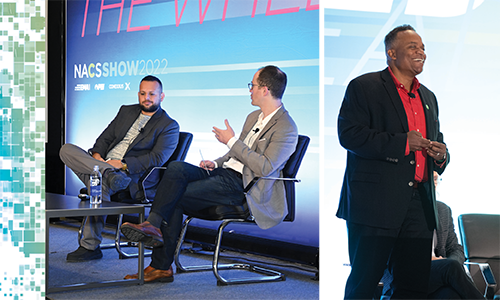 Left: [L to R] Jim Jacko, senior category for Coen Markets, and Eric Sherman, EVP, insights and analytics for GSTV, discussed how to take your c-store sales to the next level in Promotions Customers Actually Want, the most attended education session at the 2022 NACS Show. Revisiting Store Design for Your Streamlined Workforce was the second-most attended education session. Right: Derek Gaskins, Yesway’s chief marketing officer, gave an overview of the retailer’s newest c-stores.
Left: [L to R] Jim Jacko, senior category for Coen Markets, and Eric Sherman, EVP, insights and analytics for GSTV, discussed how to take your c-store sales to the next level in Promotions Customers Actually Want, the most attended education session at the 2022 NACS Show. Revisiting Store Design for Your Streamlined Workforce was the second-most attended education session. Right: Derek Gaskins, Yesway’s chief marketing officer, gave an overview of the retailer’s newest c-stores.
Jacko discussed using styles of promotions strategically to lift sales of a brand or category, or to drive more customers to the loyalty program or into the store.
“We prioritize our promotions by determining the main goal—are you trying to drive traffic or lift up products—and then we examine the products,” said Jacko.
There are the tried-and-true promotions such as two-for-one beverages or buy-one-get-one strategies. But be sure to review those promotions that have been around for a while. Are they working? For newer promotions, think of best- and worst-case scenarios.
“We all try to use whatever is in our arsenal for promotions, but if you use them all it’s hard to say what has worked,” said Jacko.
Take the time to measure results after putting in tremendous effort developing a promotion. “We work with third parties to develop models that allow us to understand the precise impact of any given promotion,” said Sherman.
Jacko asked, if you had a goal, did you achieve it? “It’s important to know. On the surface, a promotion looks successful, but in reality, from a net standpoint, it might hurt you more than help. However, a failed promotion can be just as impactful as a successful one because you sometimes learn more from it. You can come back and figure out what went wrong and areas to do better,” he said.
REVISITING STORE DESIGN FOR YOUR STREAMLINED WORKFORCE
Derek Gaskins, chief marketing officer of Yesway, and Kevin Smartt, CEO of TXB Stores, discussed how their companies are approaching new builds and remodels as the convenience landscape changes, along with the labor outlook. Their new designs encourage customer wayfinding and streamline keeping the store clean and well-maintained.
Craig Neuhoff, vice president of new business development for GSP Retail, kicked off the session with an overview of all the ways that the c-store industry has changed during the past few years, from enhancing foodservice to dealing with the pandemic to the “new normal.”
Gaskins shared how Yesway has grown to 425 stores in nine states, taking a multibrand approach with the acquisition of Allsup’s, which it continues to operate under that banner. The newest concept is Allsup’s Express, a bodega-like c-store designed for college towns and focusing on foodservice—particularly Allsup’s burritos and frozen drinks. The first store is located across from the Texas Tech University campus. It features self-checkout, mobile ordering, third-party delivery services and eat-in seating. Plus, the design is in line with the university’s mascot and colors, and college team sports play 24/7 on digital screens.
Yesway has embraced the philosophy of Allsup’s patriarch, Lonnie Allsup. “Keep it simple. Keep it consistent. Keep it within arm’s reach.” This plays out in the way the stores are designed and remodeled to maximize labor efficiency. “Labor savings have been built in,” Gaskins said. “It’s how we go to market.” For all the c-store brands, “consistency is key,” Gaskins said.
“Simplicity drives sales” at the Allsup’s Market stores, which serve as a fill-in stop for grocery items for many customers in these rural towns.
A new Allsup’s in Wolfforth, Texas, highlights best practices for a streamlined workforce. The store features a central cash-wrap counter that enables shared labor responsibilities. One person can interact with customers, sell tobacco products and do food prep from the same area. The market has an enhanced foodservice program that’s all crew-served. Dispensed beverages, from bean-to-cup coffee to a smoothie machine, are automated, and the beverage bar setup is consistent across the brand. The left side of the market is the grocery section, while the right side is convenience. A cold-case wall wraps around the store perimeter.
Private-label products get a prime spot on the endcap just inside the entrance. Large aisles allow for free customer movement and easy restocking. Restrooms are doorless to facilitate touchless entry and maintenance. In the back of the house, there’s a double door to ease intake of new stock.
 L to R: Kevin Smartt, CEO of TXB Stores, Craig Neuhoff, vice president of new business development for GSP Retail, and Derek Gaskins, chief marketing officer of Yesway.
L to R: Kevin Smartt, CEO of TXB Stores, Craig Neuhoff, vice president of new business development for GSP Retail, and Derek Gaskins, chief marketing officer of Yesway.
TXB’s new store concept, which debuted in Georgetown, Texas, last year, is all about the new brand, with its timeless black and white logo that’s carried throughout the c-store and onto the forecourt.
A muted color palette inside the store lets the merchandise pop, Smartt said. Just inside the front door, the entrance mat is bolted to the floor, making for easy cleaning, as are the polished concrete floors. Clean emerges as one theme, right down to the handwashing station for guests to use near the foodservice area. On the beverage bar, holes for under-counter receptacles to catch used coffee pucks are drilled into the granite, and there are drain troughs to catch dispensed beverage overflow—both help save on labor.
Digital menu boards can be quickly changed out with new messaging. In the cold cases, micro-glide shelves move all the bottles forward, so the cases always appear full. Outside of the building, two built- in power washers simplify cleaning the forecourt, and new stores being built will have a water cistern to help with sustainability. The legacy stores, which used to be branded Kwik Chek, now have TXB signage and a unified color scheme.
BUILD A BETTER BRAND
A brand communicates the identity of a business to the public, so it is more than necessary to get it right. At the “Build a Better Brand” education session, presenters Scott Willy, co-founder, ECD, Three Sixty Group, and Dave Bray, partner, creative and account lead, Three Sixty Group shared how to discover what your brand is, how to make it better and how to promote it both within your company and to prospective customers.
A company’s logo is the cornerstone of its brand, and it’s typically the first thing customers associate with you. It’s your visual identity. It can be difficult to know when to update.
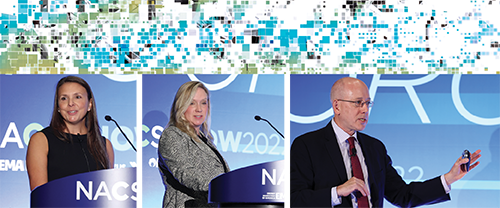 L to R: Nicole Kuhl, brand director for RaceTrac, Jeff Lenard, NACS vice president for strategic industry initiatives, and Ashley Quint, division vice president for Kum & Go, talked about how to become an employer of choice in Make Your Employer Brand Stand Out.
L to R: Nicole Kuhl, brand director for RaceTrac, Jeff Lenard, NACS vice president for strategic industry initiatives, and Ashley Quint, division vice president for Kum & Go, talked about how to become an employer of choice in Make Your Employer Brand Stand Out.
“It’s important to be honest with yourself. You may have your own opinion, but get outside opinions because what you think may not be what your customers think,” said moderator Keith Broviak, chief marketing officer, Coen Markets Inc.
When creating or updating your logo, anything you create should be clean and visually interesting. The logo should be easily seen and understood, big or small, and in color and black and white. Once you decide on your logo and colors, develop a style sheet and branding rules, and task someone to oversee the brand use to ensure consistency.
“Pick brands you think really work and compare them to your own. Evaluate your brand, have it evaluated by an outside group or reach out to trusted colleagues,” said Willy.
Typically, after a logo is created, a tagline is added and oftentimes you want to expand with rewards, loyalty or a food program. Be sure not to stray too far from your brand with arbitrary fonts or colors. Write a tagline to marry with your updated logo. Be sure to identify your unique selling proposition. What are you offering that makes you stand out among all the rest?
“A tagline needs to be direct, punchy and to the point, and it always needs to resonate with the company’s mission, vision and values,” said Bray.
The panel reiterated the importance of having a brand guide and someone to maintain brand consistency. “We call ours the gatekeeper, so even when we use things internally, we make sure staff are using the right logo, tagline with swag product, HR recruitment and even annual meetings. It’s not customer facing, but it keeps things consistent,” said Broviak. Internal messaging keeps employees informed. Additionally, be sure to integrate your updated brand in all channels, both traditional and social media.
Remember, bettering your brand isn’t a quick and easy process. “When you are so tired of your messaging, your customers are just starting to get it. It takes a long time for things to catch on. Six months is not enough,” said Broviak. “A brand is a living, breathing organism that needs care and tending.”
TURNING PRIVATE LABEL INTO A POWERHOUSE BRAND
More and more convenience retailers are creating their own private-label brand, and it is proving to be an excellent opportunity for growth and loyalty building.
 On average, 223 people attended each of the education sessions at the NACS Show
On average, 223 people attended each of the education sessions at the NACS Show
“Private label is a big deal. It makes over $200 billion in grocery sales annually, and 17.7% of all sales are private label; however, in convenience retail, only 3.7% of sales are private label. There is a huge opportunity to just match up to grocery sales,” shared Roy Strasburger, CEO, StrasGlobal, and moderator of the “Turning Private Label Into a Powerhouse Brand” education session.
Strasburger introduced speakers from TXB Stores and Yesway, who shared their companies’ journeys into private-label products. Despite the difference in size of the two, the foray into private label was similar.
Yesway, which started in 2015, went from zero to now 92 stores. In 2019, the company acquired Allsup’s stores and its private-label brand. Today, Yesway has 425 stores and a combined private-label brand. The retailer’s challenge was to bring two brands together for all customers, no matter which store they shop.
TXB is a smaller retailer with 26 stores and foodservice in half of its locations. TXB is in its third year of private-label products, and private-label serves as 2% of overall TXB sales.
The speakers set out a roadmap for starting a private-label journey. Both discussed how important it is to first establish the why for the move into private label and define the reasons for creating the product.
“Our first question was why do we want to do private labels? We wanted to create and grow brand equity, build sales and profit, diversify products and provide unique flavors and products that are unique to Texas,” said Benjamin Hoffmeyer, vice president of marketing and merchandising, TXB Stores.
Part of the journey to private label is to study the financials. Take the time to look at the numbers, and be sure you have what is needed to create a private-label brand.
Alan Adato, merchandising and procurement manager, Yesway, emphasized that when it comes to suppliers, “They will ask you a lot of questions about your business, and you’ll have many questions about their product. Financials, minimums, cost of goods, distribution (how much product can you receive) and shelf life are an important part of the journey that will require lots of spreadsheet work and time in front of the computer,” said Adato.
Minimum-size runs are often a concern. For smaller companies, local suppliers may be ideal. Find creative ways to work with vendors such as paying for labels, plate charges and packaging upfront, making it easier for the vender to say yes. Hoffmeyer shared that by doing things upfront, vendors will just need to find time on the production line and are more likely to say yes because you are less risky to them.
To solve for smaller minimums, TXB has also delved into co-branding, negotiated future breaks and joined share groups. Starting with high-volume, high-velocity products such as waters or teas is a great way to get in the game.
When it comes to private label, “Whatever your brand is today it’s going to evolve over time, so don’t be afraid of change. However, don’t forget brand consistency,” said Hoffmeyer.
Adato agreed, “You can make your packaging look any way you want, but the key is brand consistency across all products. Sometimes a particular private-label product isn’t going to work. When that happens, just make the right choice of discontinuing or replacing it, just like any other merchandise.”
Continuous marketing and growing sales are the retailer’s responsibility in private label. Use all the tools you have available, be they promotions, advertising or samples. Think through your strategy to ensure you create a sustainable private-label program.
“Have fun with your private label. You’ve invested in this product. Take the time to embrace it. Your customers will also enjoy the journey with you,” said Adato.
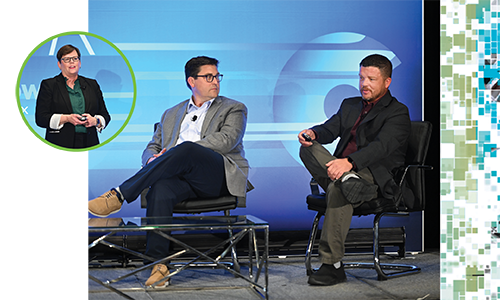 L to R: Kim Stewart, NACS Magazine editor-in-chief, moderated a panel on Self-Checkout Strategies with Josh Birdwell, vice president, guest/retail technology, Pilot Travel Centers, and Alan Meyer, CEO of Meyer Oil Company.
L to R: Kim Stewart, NACS Magazine editor-in-chief, moderated a panel on Self-Checkout Strategies with Josh Birdwell, vice president, guest/retail technology, Pilot Travel Centers, and Alan Meyer, CEO of Meyer Oil Company.
SELF-CHECKOUT STRATEGIES
Self-checkout is becoming more commonplace in convenience stores but still isn’t mainstream. Josh Birdwell, vice president, guest/retail technology, Pilot Travel Centers, based in Knoxville, Tennessee, and Alan Meyer, CEO, Meyer Oil Company, dba Mach 1 convenience stores, based in Teutopolis, Illinois, joined NACS Magazine Editor-in-Chief Kim Stewart for a fireside chat exploring how these two retail chains are using self-checkout in their stores.
Pilot has more than 800 locations, while Mach 1 has 23 locations in Illinois and Indiana. Both retailers have gone all-in on self-checkout.
Any discussion of self-checkout always comes down to how it can help ease the current labor shortage, which every retailer is grappling with now. For Birdwell and Meyer, though, adopting the frictionless technology isn’t necessarily about saving on labor.
“Reducing labor isn’t always what happens,” Birdwell said. Self-checkouts aren’t a replacement for store associates, he stresses.
Meyer agrees. “Reducing labor and labor costs is not the way to look at self-checkout,” he said. “Rather, the question is, ‘What is your labor doing?’”
Self-checkout kiosks need to be front and center and manned by a nearby associate to assist customers as needed, handle age-restricted purchases and to deter theft. Having a team member in the bullpen area as a greeter is key, especially when it comes to enhancing the customer experience. Don’t make your customers wait for assistance, which can clog up the line and only adds to the friction that you are trying to remove in the process.
While some c-stores only accept credit or debit card transactions at the self-checkout, Pilot and Mach 1 both also accept cash, even for fuel purchases, since the c-store customer still primarily pays in cash. Units that accept bills and coins are pricier, but they broaden the access for all customers, making sure that they are welcome no matter what payment method they use.
“The self-checkout needs to do everything that a traditional manual checkout can,” Meyer said. Units that accept cash benefit both the customer and the sales associate, who doesn’t need to stress out about making change, for example. When it comes to the business case for self-checkout, that shows up in increased throughput no matter the time of day and increased transaction counts in relation to labor costs.
CREATING FANS OF THE BRAND: YOUR SOCIAL MEDIA STRATEGY
Retailers looking to find creative ways to gain loyal fans of their brand heard insightful tips on social media strategy from Ariel Norwood, senior director of marketing engagement for Bounteous, who has lead the social media strategy for Wawa for the past 14 years, becoming its full digital partner.
“Sixty-four percent of consumers want brands to interact on social media. It’s becoming an expectation. It’s not really something extra,” said Norwood.
To start building or auditing your social media strategy, define what sets your brand apart or what makes it unique in your region. Consider what consumers coming to your store want or what need they are filling.
Next is to know your social media audience. You may see generational or economic differences in your digital customers. Consider how each audience might use social media—are they more likely to use TikTok or Facebook? Then, prioritize who you are trying to reach in each area.
“It’s great to have a lot of followers; however, followers in and of themselves are not the be all and end all goal,” said Norwood. “If you have 50,000 followers and strong engagement, I’d say you have a strong social media program.”
Norwood shared that when it comes to social media strategy, don’t batch and blast the same content to every channel with one audience in mind, even if that means you focus on one channel and audience. It’s better to get it right with one channel and one audience and scale from there.
Focus on your content’s tone of voice, which you will determine. Stay away from using an in-store tone since it’s a digital experience. Use language that’s appropriate for the forum.
Regardless of your intended digital strategies or goals, three pillars of social medial content are key to success. First, create relatable content from the point of view of customers and what matters to them. Second, focus on incentives and promotions. Include not only discounts but also giveaways, sweepstakes or exclusive offers that only happen on social media. Incentives are anything that encourages your followers and visitors to engage with you.
Finally, consider education. Education as a broad definition informs consumers of what’s happening in your store. Inform your audience by sharing products that are available in a relatable way and what customers can expect when they come into your store.
Set measurable goals by tracking posts with category content, and look at how that content is performing. Consider if content in one category is stronger. Is there a reason one category is doing better than others, and are you using the tone of voice you intended?
“Motion graphics are a win no matter what, so if you have a category that’s lagging, try it or perhaps including people works better. You can use the people in your company; you don’t need to find models,” said Norwood. “All of these are things you can track over time.”
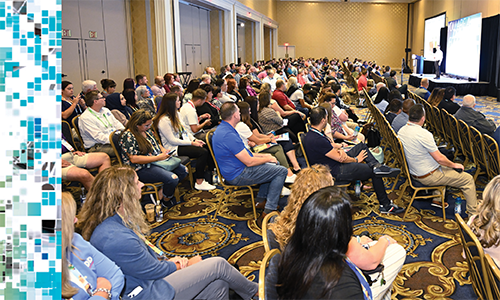 Attendees could pick from more than 40 education sessions created by convenience retailers for retailers.
Attendees could pick from more than 40 education sessions created by convenience retailers for retailers.
SUPERCHARGE YOUR APP
One way to increase customer loyalty is to leverage your mobile app. Successful retailers use their apps to drive foot traffic while making the in-person shopping experience easier, safer and way more fun.
“The role of the app in the customer journey can modernize the customer experience if we are intentional that the entire customer journey is seamless and frictionless, i.e., a unified commerce experience,” said Lucia Romanello Crater, executive vice president of sales and business development for Impact 21 and moderator of the “Supercharge Your App” education session.
Hayley Thrift, director of marketing for The Spinx Company, discussed how by partnering with a third party, Spinx was able to add functionality to its app and capture data, plus increase engagement. Spinx used the app to streamline its annual chicken campaign. Customers were able to automatically sign up for the promotion when they scanned the app versus when employees put stickers on boxes and the customer was expected to keep the box and go online to enter the contest for a year of free chicken.
“Once we engaged a digital strategy, the entry rate rose 5 times in the first year, then it was record-breaking when we hit 10,000 entries, and it made the process easier for the customer and us,” said Thrift.
At Kwik Trip Inc., David Jackson, digital marketing and loyalty manager, wanted an app that was something more than a location finder, so in 2018, Kwik Trip launched its custom-designed app.
Jackson shared three features that have contributed to the app’s success. First is messaging—push, inbox, in-app and pop-ups. The ability to regularly communicate with customers is the foundation of what makes the app so successful. While not necessarily an app feature, SMS messaging adds to success because it helps drive consistent traffic to the app.
“Knowing that our customers have different preferences on how they want to communicate, using all the channels available are useful for driving traffic to the app and to our stores,” said Jackson. “If you don’t have an app today, look at SMS. It was a great way to get started.”
Mobile ordering was the next feature Jackson highlighted. Kwik Trip launched mobile orders in 2022 with curbside and delivery service. An e-commerce platform and third-party services support KT’s delivery efforts.
 Left: Tony Sparks (right), head of customer wow for Curby’s Market, connected with an audience member during the Q&A portion of Prioritizing the Customer Experience. Right: Merrick Rosenberg is CEO of Take Flight Learning.
Left: Tony Sparks (right), head of customer wow for Curby’s Market, connected with an audience member during the Q&A portion of Prioritizing the Customer Experience. Right: Merrick Rosenberg is CEO of Take Flight Learning.
“From a project and technology standpoint, implementing mobile ordering was pretty straightforward. The biggest piece of mobile ordering is execution in the store. It’s a big change for stores,” said Jackson.
The third–and most fun–feature is the gamification of the app. Gamification created a downstream effect that drove customer interaction with the app daily, use of more features and of coupons.
Denise Jenkins, vice president of marketing for United Dairy Farmers discussed what the convenience retailer’s journey has been like during the past four years while evolving its app. Jenkins shared tenets critical to success: Make it personal, make it exclusive and make it unique.
For personalization, the app addresses members by name and sends coupons on the customer’s birthday. The app is also used for two-way communications. “When we do surveys for product development and ask questions about flavors, etc., people really appreciate the fact that you are asking their opinion. They love being involved,” said Jenkins.
Being exclusive means providing offers or deals in store or offers exclusive to loyalty members, providing a VIP experience. That includes features such as gas-price information, cents-off gas and other promotions that allow customers to redeem things in store.
For UFD, being unique was quite easy. Customers can save on gas and get an ice cream only made by the company. App-only giveaways are another unique offering.
REINVIGORATING DISPENSED BEVERAGES
Historically, c-stores have excelled in the dispensed beverage category, so why are they struggling to recapture the market share they had in 2019? “Things have happened that have made things a little bumpy,” said Chris Rapanick, NACS director of business development. “I’m not going to say the C-O-V-I-D word ... but obviously business fell off in 2020. Some places were closed. There were mandates that prevented running dispensed beverages. Consumers were a little wary. So, the business was impacted.”
Rapanick, who moderated “Gulp! Reinvigorating Dispensed Beverages,” said things in this market segment are in the beginning stages of recovery, mainly because of increased prices (partly due to inflation), but still lag in unit sales.
To boost beverage sales, c-stores are doing a number of inventive things to reinvigorate the market, including introducing mixology, creating loyalty sip- and-save programs, partnering with brands to create store-specific beverages and using social media to promote this category.
Ryan Ratcliffe, dispensed beverage category manager for Maverik, said consumers seem to be looking for something a little bit different in the beverage category and are willing to wait in long lines to get it. When soda shops began to pop up around him in Utah, he took notice.
“People are paying a premium for this and will line up around the block to get it. That bothers me,” he said. “So, my goal this past year was to find a way to compete with that.”
In response, Maverik has developed its own style of mixology and taken it to social media to create a beverage buzz—and it’s working. “You can create that same soda shop drink here and save yourself some money,” Ratcliffe said.
For Circle K, boosting dispensed beverages involved working with PepsiCo to create a drink exclusive to Circle K. The result: Purple Thunder and a 360-degree promotion campaign for in-store and social media, said David Hall, vice president of global foodservice for Circle K.
Additionally, Circle K launched a new sip-and- save program to create value and loyalty. For $5.99 a month, customers can get one drink a day.
“We are looking at anything we can do to drive that traffic and create patterns of participation,” Hall said. Driving consumers toward dispensed beverages in-store is also critical, said Jose Salinas, director of C&G Channel for Marmon. Adding screens at the dispensers is a great way to capture their attention. “There is a 3-19% sales increase when you have that interactive digital screen,” he said.
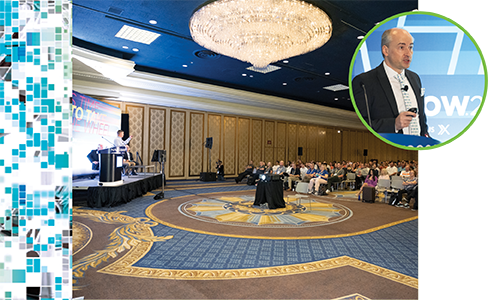 Left: Attendees at the Gulp! Reinvigorating Dispensed Beverages education session heard advice about ways to reignite sales in this key trip driver, which took a hit early during the pandemic. Right: Mark Wohltmann is director of NACS Global.
Left: Attendees at the Gulp! Reinvigorating Dispensed Beverages education session heard advice about ways to reignite sales in this key trip driver, which took a hit early during the pandemic. Right: Mark Wohltmann is director of NACS Global.
READY-TO-DRINK COCKTAILS ARE SHAKING UP THE COLD BOX
Ready-to-drink beverages (RTDs) skyrocketed in popularity during the pandemic as restaurants and bars were shuttered, but demand has remained strong, said Jon Berg, vice president of thought leadership for beverage alcohol at NielsenIQ.
“Spirits-based RTDs have seen a particularly impressive growth at 55%, and this trend is likely to continue,” Berg said. “Consumers enjoy the product simplicity, and spirits RTDs take the intimidation out of mixing a drink for themselves or for guests.”
Berg expects that double-digit growth rate to continue in the RTD spirits category, although he notes that, in an era of seemingly endless options, hard soft drink and hard seltzer manufacturers may face challenges.
“Hard soft drinks are poised for development,” he said, “but lower cost alternative brands could come into the market just as retailers need to promote more as consumers exhibit recessionary behaviors, such as seeking deals. Also, look for branded private labels to jump into this subsegment.
“Hard seltzer,” he said, “will need new innovation elements. Package type and flavor have been innovations during the growth period to remain relevant, but new value-added components are needed. Watch for ‘good-for-you’ ingredients and claims seeking to reinvent.”
And what about wine?
“Roughly 30% of RTD purchases are reminded/impulse purchases that rely on brand affiliation,” Berg said. “Well-known wine brands have leverage here. Creating sparkling wine cocktails—sangrias, mimosas, spritzers and bellinis—should be top of mind, as these beverages are often viewed as adjacent to RTD spirits.”
If variety is the spice of life—and of the liquor cabinet—c-stores that can use their cold vaults to provide customers with a breadth of choices will be well-served. How to choose your inventory could be as simple as considering your retail location. Is shopping a primary mission? If so, having a representation of all key segments is essential, said Berg.
Your location may also influence the primary demographics of your customer base, which in turn impacts which alcohol you should have on hand. “We tend to see shoppers in the 35- to 55-year-old range skew the highest for purchase of overall RTDs,” said Berg. “Higher income levels also index toward spirits-based RTDs. Hard seltzers have been more appealing to 21- to 44-year-old consumers.”
GLOBAL FOODSERVICE TRENDS AND MENUS
Foodservice is the key to capturing a bigger share of your customers’ wallets. “Customers fuel their cars one time a week, but they fuel their bodies three times a day,” said Frank Gleeson, president and CEO of Aramark Northern Europe and a former NACS chairman. “Customers want to buy food and beverages, and if you create the opportunity for them, you will win.”
In Northern Europe, the current focus is on high-end artisan food and cracking the take-home market, Gleeson said. Because of the pace of technology, retailers must move quickly if they want to keep up—much less stay ahead. He advises others wanting to become or stay relevant in foodservice to focus on technology, flexibility and evolution.
“Technology is moving so fast, it’s really about the pace of that change,” he said. “Everyone has raised their game because of the competitive market. The evolution has to move all the time. You cannot sit still. The store today won’t succeed in the future.”
In South Africa, the food focus is all about a diverse range of products. Joe Boyle, managing director for FreshStop South Africa, describes the country as one of extremes. Extreme rich and poor, hot and cold, friendly and violent.
FreshStop stores offer a large variety of foodservice in a small space to give customers what they want. From fried and grilled chicken to sausage and salmon, these APCs account for 30-35% participation in the food area.
Boyle said even stores with little space can enter the foodservice market. “Look at appetite and space, and start with one APC and then build it up,” he said. “Make it as easy as possible by using products that are 90% prepared before coming to the store.”
Central American c-stores offer typical food products such as pizza, subs and hamburgers, but they also offer traditional local products from independent producers, said Pablo Andonie, president and CEO of AMPM Centro America.
“Each country has different products and typical traditional things, so we offer items that appeal to that market. Diversity is the key word,” Andonie said.
In Georgia, Saba Jishiashvili, COO of Sun Petroleum (Gulf) Georgia, created a market for hotdogs—a completely new food for that region. That market skyrocketed from selling 500 hotdogs per day to 30,000 per day now.
Mark Wohltmann, NACS global director, moderated the panel and noted that he remembers when foodservice at c-stores was just a concept.
“In the early ’90s, our industry was talking a lot about foodservice as an idea. Now, 30 years later, here we are in a packed room talking about real foodservice.”
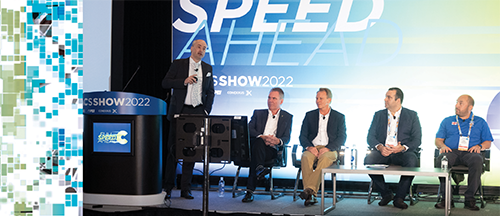 L to R: Mark Wohltmann, NACS Global; Frank Gleeson, president and CEO of Aramark Northern Europe; Joe Boyle, managing director of Fresh Stop; Pablo Andonie, president and CEO of AMPM Centro America; and Saba Jishiashvili, COO of Sun Petroleum Georgia, discussed global foodservice trends.
L to R: Mark Wohltmann, NACS Global; Frank Gleeson, president and CEO of Aramark Northern Europe; Joe Boyle, managing director of Fresh Stop; Pablo Andonie, president and CEO of AMPM Centro America; and Saba Jishiashvili, COO of Sun Petroleum Georgia, discussed global foodservice trends.
FOODSERVICE ANALYTICS: THE RECIPE FOR SUCCESS
Convenience retailers shouldn’t be winging it when it comes to foodservice—even if wings themselves happen to be their specialty. Data and analytics are critical in all profitable enterprises, and food is no exception.
“In addition to the POS and back-office systems, there are specific systems needed for foodservice management,” said Kay Segal, president and managing executive of Business Accelerator Team. From managing waste and cost to planning an efficient production and a data-driven menu, these technologies can—and should—support operations at every turn.
“On the equipment side, ovens and other foodservice equipment with IoT allow you to monitor equipment and push out menu updates from a central location,” said Paul Servais, retail operations food service director for Kwik Trip. “This is huge for chains with multiple stores. From a data standpoint, there are so many ways to gather it, from homegrown systems to purchasing a suite of software that will require 20 or more IT experts to implement and interpret the data. These are struggles we all deal with, and there’s no easy answer,” Servais said.
“A baseline for any strong food analytics platform is a well-organized price book,” adds Steven Turner, vice president of foodservice and strategic sourcing for Refuel Operating Company. “Having consistent item numbers, UPCs and menu descriptions and removing ‘open food keys’ will allow you to accurately measure performance, manage recipes and pricing and build tools to optimize performance.”
Turner also recommends Wi-Fi-connected labeling systems for easy updates of prices and menus, as well as production management tools to guide what to prepare and when to prepare it.
“A well-developed production management tool does two things,” said Turner. “It grows sales by having the right product out at the right time and improves profitability by making sure you don’t have the wrong items out at the wrong time.”
Just breaking into foodservice? Turner has advice there, too.
“The No. 1 thing for anyone just getting into food is sales is this: Are you growing sales units and dollars? Focusing too early on anything else will stifle growth and limit your long-term profitability,” Turner said.
“As you are building out your food program, looking at things like recipe costs and menu margin analysis (how profitable each menu item is at a specific retail price) will help make sure you are setting yourself up for success.
“When we open new stores or add food to new locations, we do not set profit targets until after 90 days— only sales targets,” he said. “For those that aren’t new, regular reviews of menu performance is something that often gets neglected. Bottom-performing items in sales (units) and margin (dollars) should be reviewed, reworked and/or removed. In my experience, doing this allows you and your team to focus more energy on the profitable part of your business.”
PRIORITIZING THE CUSTOMER EXPERIENCE
Personalization is the holy grail—in data and how it translates to molding your business to better serve customers. That was the message at “Prioritizing the Customer Experience,” where Tony Sparks, head of customer wow for Curby’s Market, and Peter Rasmussen, CEO and founder of Convenience and Energy Advisors, tag-teamed a presentation that included a look at data harvesting and how to parlay it into a meaningful and relevant customer experience.
Elevating the customer experience always begins with data, Rasmussen said. Although marketers and operations have plenty of data, they struggle to mine it, surface their most important customer segments and respond to their customer needs in real time.
In fact, 95% of data within organizations remains untapped. “In a world with too much data, find the points that matter,” he said. “Customers are going to lean toward brands that do that well.”
Data not only can tell you what your customers want right now but combining it with machine learning can add a predictive element that can tell you what they’ll want tomorrow or next week. In fact, predictive analysis is the future of data, said Sparks.
“Data is the science, but it’s really only half the story,” he said. “There is an art to taking it and actually doing something with it. Data is just things that have happened in the past that reveal customer behavior.”
Apps are a good way for companies to collect data while providing a customer experience, but the world is “over-apped” these days, said Rasmussen. It is difficult to get people to use your app, much less add a payment to it.
“Ninety percent of consumers use loyalty apps but are less likely to do so for c-stores,” he said, which is why a multichannel approach can help you connect with your customers. Third-party apps like Upside can help you fill in the gaps during your non-peak hours and bring first-time customers to your c-store.
“I have a lot of respect for Upside and how they have caused a disruption,” Rasmussen said. “They have 30 million users and could ultimately lead them to our stores.”
SPONSOR SHOUTOUT
New this year, NACS hosted a Food Safety Conference on October 1—the first industry-specific event of its kind for the global convenience retail community. “NACS members have a role to play to move the industry in the right direction and help our businesses reduce their risks and protect their brands,” said Dr. Jay Ellingson, chief scientific officer at Wisconsin-based Kwik Trip and conference moderator.
NACS extends a special thank you to our NACS Food Safety Conference Premier sponsor, Ecosure, a division of NACS Hunter Club member Ecolab, and our General sponsor, Testo, for their dedication and expertise to advance food safety and safe foodhandling procedures and processes in the convenience retail industry. Their support contributed to the success of the inaugural NACS Food Safety Conference. Visit Ecosure at www.ecolab.com/solutions and Testo at www.testo.com to learn more.

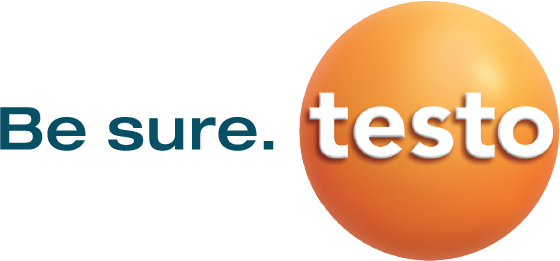
MISS A SESSION? WE GOT YOU!
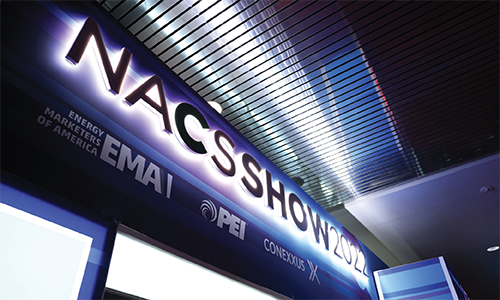 With NACS Show on-demand sessions, there are learning opportunities for everyone. From embracing new technology to enhancing the customer experience, there’s a chance to learn from real-world industry insiders and retail superstars who are shaping the future of convenience.
With NACS Show on-demand sessions, there are learning opportunities for everyone. From embracing new technology to enhancing the customer experience, there’s a chance to learn from real-world industry insiders and retail superstars who are shaping the future of convenience.
The NACS Show education sessions are designed by industry peers to make you and your entire team better. Whether you’re just starting out with a new idea, growing your skill set, or thinking strategically about an expansion, our on-demand education session recordings will help you plan a learning experience that’s tailored to your specific needs and goals.
Go to www.NACSShow.com to learn more.